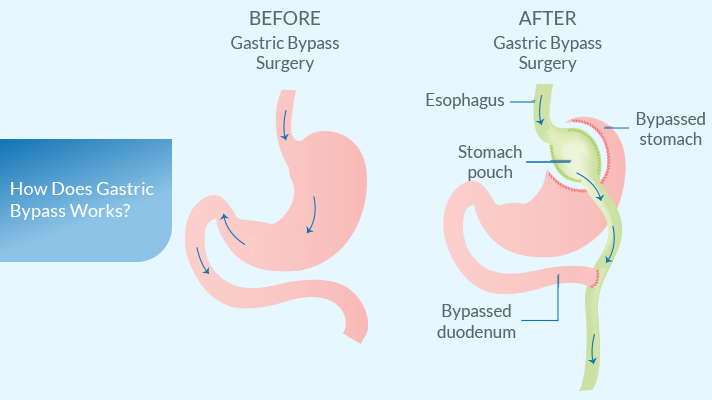
Do you want to lose that stubborn weight that couldn't be shredded off through exercising or dieting? Do you want to avoid the risk of type 2 diabetes mellitus, high blood cholesterol or triglycerides?
Well, guess what?
If you answered yes to the above questions, then all you need is a Gastric Bypass surgery. If you'd want to know more about this surgery, then continue reading.
ALSO CHECK: Am I Fat or Obese?
What is Gastric Bypass?
Gastric bypass surgery is an invasive surgical procedure that involves dividing the stomach into a small upper pouch and a larger lower pouch. The basic idea of this surgery is to shrink the size of your stomach so that you don’t eat as much food as you used to. Simply put, part of your digestive system will be bypassed so that you don’t consume as much food.
There are two common types of gastric bypass surgery, and these are:
Roux-en-Y gastric bypass is the most common type. This type of gastric bypass surgery requires surgeons to make a small incision, and this means that it has a quicker recovery period.
When performing this surgery type, your doctor is going to make a small pouch by vertical banding or stapling part of the stomach together. This restricts excess eating.
The surgeon will then attach a Y-shaped part of the small intestine to the pouch. This makes the food skip part of your digestive system, and as a result, you begin to lose weight as you consume fewer calories and food.
Extensive gastric bypass is the less common type because probably because it is more complicated. Your surgeon will remove the lower part of your stomach and the remaining small pouch is connected directly to the last section of the small intestine, and this bypasses the first two parts completely. This type is effective for weight loss, but it’s not the most preferred type because it is very complicated and can leave a patient short on nutrients.
How is it performed?
Fifteen mins before the surgery, your surgeon will give you general anesthesia that will send you into a deep sleep. This is done so that you don't feel any sort of discomfort during the surgery.
After the general anesthesia has kicked in, the operation will begin. In most cases, the Gastric bypass operation involves two steps:
- The first step aims to make your stomach smaller. Staples are used to dividing your stomach into two sections: larger bottom section and a smaller upper section. The pouch (the top section of the stomach) will contain the food you will eat. The size of the pouch is as small as a walnut. It is made to be this small so that you eat less and shed some pounds.
- The bypass is the second step. The jejunum (small parts of your small intestines) is connected to a small hole in your pouch. The food in the pouch will pass by this new opening into your small intestines. This will make your body absorb little calories.
Surgeons usually use the above-mentioned steps of Gastric bypass. They can either use open surgery or they use a tiny camera known as the laparoscope.

What is the recovery time?
Most often than not, gastric bypass surgery is laparoscopic, which means the surgeon makes small cuts. That makes for shorter recovery time. Soon after the surgery, you are recommended to stay in the hospital – under the close supervision of your surgeon – for two to three days.
When discharged from the hospital, patients are expected to avoid any physical activity that is vigorous. Your surgeon is more likely to give you a list of meds to take after the surgery, and this is done in case you feel any sort of discomfort. Patients are expected to resume normal activities in three to five weeks after the surgery.
Speaking of Gastric Bypass, Dr. Serkan is one name that springs to mind. This Turkish doctor has mastered his craft when it comes to Gastric Bypass surgery and any other treatment procedures for obesity, diabetes and reflux. Dr. Serkan has performed over a thousand surgeries that have over a 90% success rate.
.jpg)
Besides having performed more than 1000 obesity and anti-reflux operations, Dr. Sekan has contributed immensely in this field. He prepared a measurement report on the evaluation of patients pre- and post-operative conditions. Some of the medical congresses that he has participated in are: National Surgical Society Medical Congress and IFSO World Obesity and Metabolic Diseases Congress.






























Take The First Step Get Started!
Our team will dedicate their effort and time to help you choose the clinic best for you. Our goal is not just to find ‘a doctor’ for you, but to find ‘the right doctor’.








